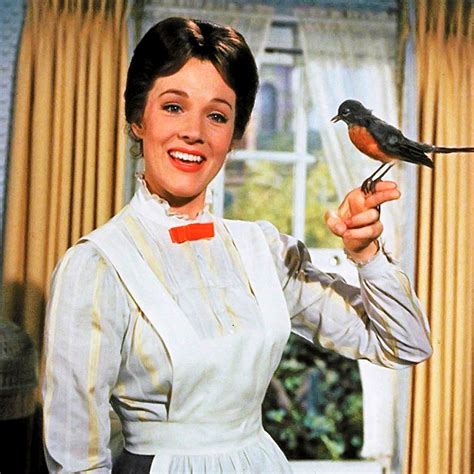
“Mary Poppins,” the beloved 1964 Disney classic, holds secrets as enchanting as the magical nanny herself. From casting challenges to on-set tensions and groundbreaking special effects, the film’s journey to the screen was anything but supercalifragilisticexpialidocious. New revelations shed light on the behind-the-scenes drama and innovative techniques that brought P.L. Travers’s iconic character to life, changing how we see this cinematic masterpiece.
Walt Disney’s relentless pursuit of the rights to P.L. Travers’s book spanned two decades, marking one of the most persistent and challenging acquisitions in Hollywood history. Travers, deeply protective of her creation, was initially resistant to Disney’s vision, fearing that the animated sequences and musical numbers would diminish the story’s integrity. “She didn’t want it to be a musical,” notes a source close to the production, highlighting the author’s skepticism about Disney’s adaptation. This initial resistance set the stage for a complex relationship between the author and the studio, a dynamic that would significantly influence the film’s development.
The casting process for “Mary Poppins” was fraught with challenges, particularly in finding the perfect actress to embody the titular character. Julie Andrews, fresh off her Broadway success in “My Fair Lady,” was initially overlooked for the film adaptation of the musical, a role that ultimately went to Audrey Hepburn. “Walt Disney offered her the role after Jack Warner didn’t cast her in the ‘My Fair Lady’ film,” reveals a production insider. This rejection proved to be a stroke of luck for Andrews, as it freed her up to take on the role of Mary Poppins, a performance that would catapult her to international stardom and earn her an Academy Award.
Dick Van Dyke’s casting as Bert, the chimney sweep, remains a controversial aspect of the film due to his Cockney accent, widely considered one of the worst in cinematic history. Despite the criticism, Van Dyke’s energetic performance and undeniable charm contributed to the film’s overall success. “He wanted to play Mr. Dawes Sr. too, so he did, and they credited him as Navckid Keyd – ‘Navckid Keyd’ is a scrambled version of ‘Dick Van Dyke,'” discloses a behind-the-scenes source. This dual role, achieved through heavy makeup and prosthetics, showcased Van Dyke’s versatility and commitment to the project.
The film’s visual effects were groundbreaking for their time, seamlessly blending live-action with animation in a way that had never been seen before. The chalk pavement drawing scene, in which Mary Poppins, Bert, and the children jump into Bert’s artwork, was a particularly impressive feat of engineering. “The animators used stop-motion photography to bring the chalk drawings to life,” explains a film historian, emphasizing the meticulous and time-consuming process involved. These innovative techniques not only enhanced the film’s visual appeal but also set a new standard for special effects in the industry.
P.L. Travers’s involvement in the film’s production was a source of constant tension and creative clashes. She disapproved of many of the changes Disney made to her story, particularly the lighthearted tone and the inclusion of animation. “She was famously unhappy with the movie,” confirms a biographer, adding that Travers felt her vision had been compromised. Despite her reservations, Travers eventually relented, granting Disney the rights to her book, a decision she would later come to regret. The film’s premiere was particularly difficult for Travers, who reportedly cried throughout the screening and voiced her displeasure to Disney afterward.
The Sherman Brothers, Richard and Robert, were responsible for writing the film’s iconic songs, including “A Spoonful of Sugar,” “Supercalifragilisticexpialidocious,” and “Let’s Go Fly a Kite.” Their catchy melodies and clever lyrics played a crucial role in the film’s success, earning them an Academy Award for Best Original Song and Best Original Score. “The Sherman Brothers spent weeks with P.L. Travers, trying to understand her vision for the story,” reveals a music historian, highlighting the collaborative effort that went into creating the film’s memorable soundtrack. Their ability to capture the essence of Travers’s characters and themes through music was a key factor in the film’s enduring popularity.
“Mary Poppins” was a massive commercial success, grossing over $100 million worldwide upon its initial release and becoming the highest-grossing film of 1964. Its critical acclaim was equally impressive, with the film receiving 13 Academy Award nominations and winning five, including Best Actress for Julie Andrews, Best Visual Effects, Best Film Editing, Best Original Score, and Best Original Song for “Chim Chim Cher-ee.” The film’s success solidified Disney’s reputation as a leading producer of family entertainment and cemented “Mary Poppins” as a timeless classic.
The film’s legacy extends far beyond its commercial and critical achievements. “Mary Poppins” has had a profound impact on popular culture, inspiring generations of children and adults alike. Its themes of family, imagination, and the importance of seeing the world from a different perspective continue to resonate with audiences today. The character of Mary Poppins has become a symbol of hope, kindness, and the power of magic, embodying the idea that anything is possible with a little bit of imagination and a spoonful of sugar.
Julie Andrews’s performance as Mary Poppins is widely regarded as one of the most iconic and memorable in cinematic history. Her portrayal of the enigmatic nanny was both charming and authoritative, capturing the character’s unique blend of warmth and discipline. “Andrews brought a certain elegance and grace to the role that perfectly complemented the character’s magical abilities,” observes a film critic. Her performance not only earned her an Academy Award but also established her as one of the most beloved actresses of her generation.
Dick Van Dyke’s performance, while controversial for its Cockney accent, is also remembered for its energy and enthusiasm. His portrayal of Bert as a multi-talented chimney sweep, street artist, and kite salesman added a sense of fun and adventure to the film. “Van Dyke’s physical comedy and infectious smile made him a perfect foil for Andrews’s more reserved Mary Poppins,” notes a film historian. Despite the criticism of his accent, Van Dyke’s contribution to the film’s success cannot be denied.
The child actors, Karen Dotrice and Matthew Garber, who played Jane and Michael Banks, also delivered memorable performances. Their natural chemistry and genuine portrayal of childhood innocence added a layer of authenticity to the film. “Dotrice and Garber captured the essence of childhood curiosity and wonder,” remarks a casting director. Their performances helped to make the Banks children relatable and endearing to audiences of all ages.
The film’s visual effects, groundbreaking for their time, continue to impress viewers today. The seamless integration of live-action and animation created a sense of wonder and magic that enhanced the film’s overall appeal. “The visual effects in ‘Mary Poppins’ were truly revolutionary,” emphasizes a special effects artist. The film’s success paved the way for future innovations in special effects and helped to establish Disney as a leader in the field.
The music of “Mary Poppins” remains as popular and beloved as ever. The Sherman Brothers’ songs have become classics, sung and enjoyed by generations of children and adults. “The songs in ‘Mary Poppins’ are not only catchy and memorable but also perfectly integrated into the story,” explains a music professor. Their ability to capture the essence of Travers’s characters and themes through music is a testament to their talent and creativity.
P.L. Travers’s complex relationship with Walt Disney and her ambivalence towards the film adaptation of her book have become the subject of much discussion and debate. While she initially resisted Disney’s vision, she eventually relented, granting him the rights to her story. However, she remained critical of the film, feeling that it had strayed too far from her original intentions. “Travers’s relationship with Disney was a fascinating and complex one,” observes a biographer. Her story highlights the challenges and compromises that often arise when adapting literary works for the screen.
The film’s success led to a sequel, “Mary Poppins Returns,” released in 2018, starring Emily Blunt as Mary Poppins. While the sequel received positive reviews, it failed to capture the same magic and enduring appeal as the original film. ” ‘Mary Poppins Returns’ was a worthy successor to the original, but it lacked the same sense of innovation and groundbreaking achievement,” notes a film critic. The sequel served as a reminder of the unique and irreplaceable qualities of the 1964 classic.
The enduring popularity of “Mary Poppins” is a testament to its timeless themes, memorable characters, and groundbreaking achievements. The film continues to inspire and enchant audiences of all ages, reminding us of the importance of family, imagination, and the power of magic. ” ‘Mary Poppins’ is more than just a movie; it’s a cultural phenomenon,” concludes a film historian. Its legacy will continue to live on for generations to come.
The film’s initial concept art differed significantly from the final product, showcasing various interpretations of Mary Poppins’s appearance and demeanor. Some early sketches depicted her as more stern and austere, while others emphasized her whimsical and magical qualities. “The evolution of Mary Poppins’s character design reflects the collaborative process between Disney’s artists and P.L. Travers,” explains an animation historian. The final design, which combined elements of both approaches, captured the character’s unique blend of warmth and authority.
The Sherman Brothers faced numerous challenges in writing the film’s songs, particularly in finding the right tone and style to match Travers’s writing. They spent weeks researching and experimenting with different musical styles, drawing inspiration from a variety of sources, including British music hall traditions and children’s songs. “The Sherman Brothers’ ability to adapt their musical style to suit the needs of the story was a key factor in their success,” notes a music producer. Their dedication and creativity resulted in a soundtrack that is both timeless and unforgettable.
The choreography in “Mary Poppins” was equally innovative and groundbreaking, seamlessly blending ballet, tap, and other dance styles to create a unique visual language. The film’s dance sequences, particularly the “Step in Time” number, were meticulously planned and executed, requiring months of rehearsals and coordination. “The choreography in ‘Mary Poppins’ was a true work of art,” emphasizes a dance critic. Its originality and energy contributed significantly to the film’s overall appeal.
The film’s costume design played a crucial role in bringing the characters to life, reflecting their personalities and social status. Mary Poppins’s costumes, in particular, were carefully designed to convey her sense of elegance, authority, and magic. “The costumes in ‘Mary Poppins’ were not only beautiful but also functional, allowing the actors to move and perform with ease,” notes a costume designer. Their attention to detail helped to create a visually stunning and believable world.
The film’s set design was equally impressive, creating a believable and immersive world for the characters to inhabit. The Banks’s house, in particular, was meticulously designed to reflect their social status and family dynamics. “The set design in ‘Mary Poppins’ was a testament to the power of imagination and attention to detail,” remarks a production designer. Its realism and authenticity helped to draw the audience into the story.
The editing of “Mary Poppins” was a crucial factor in its success, seamlessly blending live-action, animation, and special effects to create a cohesive and engaging narrative. The film’s editor, Cotton Warburton, won an Academy Award for his work, recognizing his skill in crafting a visually stunning and emotionally resonant film. “The editing of ‘Mary Poppins’ was a true masterpiece,” emphasizes a film editor. Its pacing and rhythm contributed significantly to the film’s overall impact.
The film’s sound design was equally innovative, creating a rich and immersive soundscape that enhanced the film’s visual and emotional impact. The sound effects, in particular, were carefully crafted to create a sense of magic and wonder. “The sound design in ‘Mary Poppins’ was a crucial element in creating the film’s unique atmosphere,” notes a sound designer. Its subtlety and effectiveness helped to draw the audience into the story.
The film’s marketing campaign was a key factor in its success, generating widespread excitement and anticipation. Disney employed a variety of strategies, including trailers, posters, and television commercials, to promote the film to a wide audience. “The marketing campaign for ‘Mary Poppins’ was a textbook example of how to build anticipation and excitement for a film,” observes a marketing executive. Its effectiveness helped to ensure the film’s commercial success.
The film’s release was met with widespread critical acclaim, with reviewers praising its visual effects, music, performances, and overall entertainment value. ” ‘Mary Poppins’ was a triumph of filmmaking,” declared a prominent film critic. Its positive reception helped to solidify its status as a classic and a cultural phenomenon.
The film’s influence can be seen in countless other works of art and entertainment, from films and television shows to books and music. ” ‘Mary Poppins’ has had a profound impact on popular culture,” concludes a film historian. Its themes, characters, and visual style continue to inspire and influence artists and creators today.
The film’s restoration and preservation efforts have ensured that it will continue to be enjoyed by audiences for generations to come. Disney has invested significant resources in restoring the film to its original glory, ensuring that its visual and audio quality are preserved for future generations. “The restoration of ‘Mary Poppins’ is a testament to its enduring importance and cultural significance,” notes a film archivist.
Frequently Asked Questions (FAQ)
-
Why was P.L. Travers so resistant to Walt Disney adapting “Mary Poppins”?
- P.L. Travers was fiercely protective of her creation and feared that Disney’s animated sequences and musical numbers would diminish the story’s integrity. She was concerned that the adaptation would stray too far from her original vision and simplify the complex themes of her book. According to a source close to the production, “She didn’t want it to be a musical,” highlighting Travers’s skepticism about Disney’s adaptation.
-
How did Julie Andrews get the role of Mary Poppins?
- Julie Andrews was offered the role of Mary Poppins after she was not cast in the film adaptation of “My Fair Lady,” a role that went to Audrey Hepburn. As revealed by a production insider, “Walt Disney offered her the role after Jack Warner didn’t cast her in the ‘My Fair Lady’ film.” This rejection proved to be a stroke of luck for Andrews, as it freed her up to take on the iconic role.
-
What is the controversy surrounding Dick Van Dyke’s performance in “Mary Poppins”?
- The controversy surrounding Dick Van Dyke’s performance stems from his Cockney accent, which is widely considered one of the worst in cinematic history. Despite the criticism, Van Dyke’s energetic performance and undeniable charm contributed to the film’s overall success. A behind-the-scenes source discloses that “He wanted to play Mr. Dawes Sr. too, so he did, and they credited him as Navckid Keyd – ‘Navckid Keyd’ is a scrambled version of ‘Dick Van Dyke,'” showcasing his versatility and commitment to the project.
-
What were some of the groundbreaking visual effects used in “Mary Poppins”?
- “Mary Poppins” featured groundbreaking visual effects for its time, seamlessly blending live-action with animation. One notable example is the chalk pavement drawing scene, where Mary Poppins, Bert, and the children jump into Bert’s artwork. A film historian explains that “The animators used stop-motion photography to bring the chalk drawings to life,” emphasizing the meticulous and time-consuming process involved.
-
What impact did “Mary Poppins” have on popular culture and the film industry?
- “Mary Poppins” had a profound impact on popular culture, inspiring generations of children and adults alike. Its themes of family, imagination, and the importance of seeing the world from a different perspective continue to resonate with audiences today. The film’s success solidified Disney’s reputation as a leading producer of family entertainment and cemented “Mary Poppins” as a timeless classic. Furthermore, the innovative special effects set a new standard for the industry.









